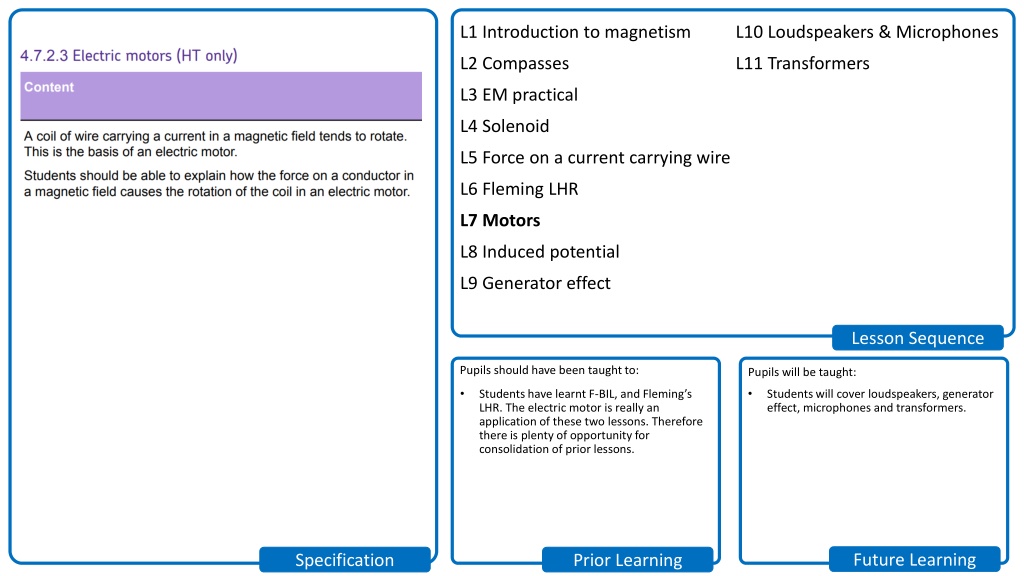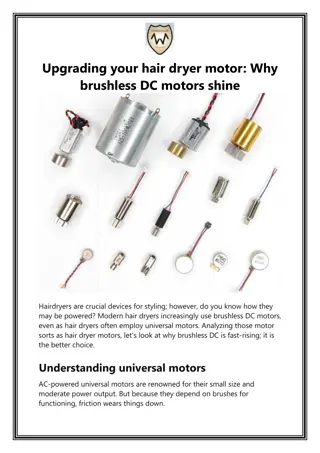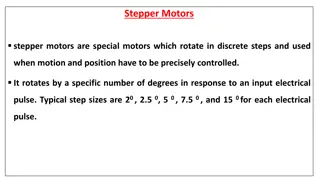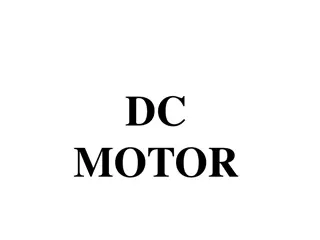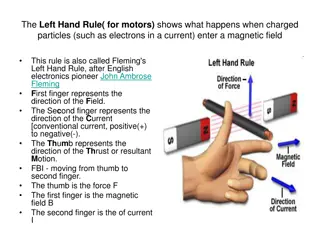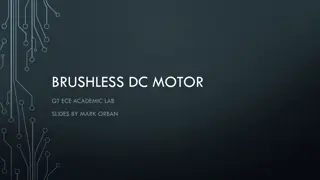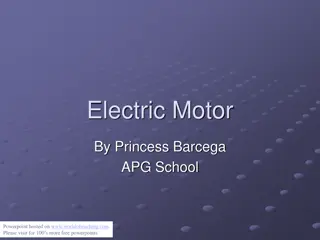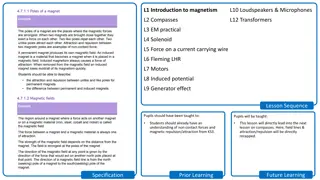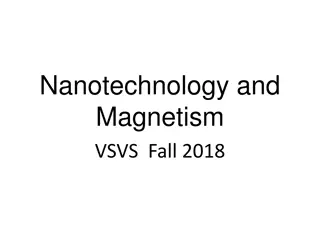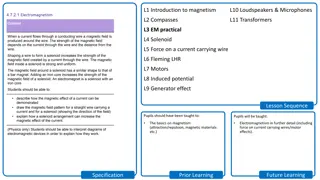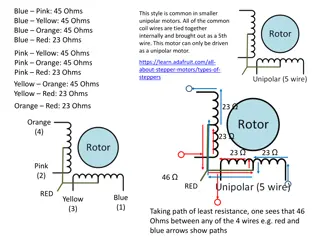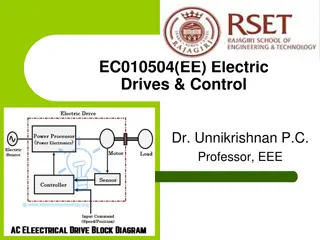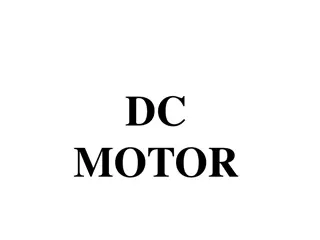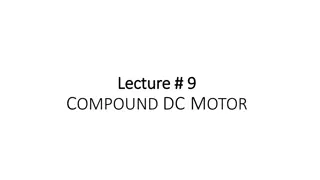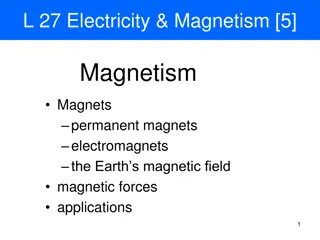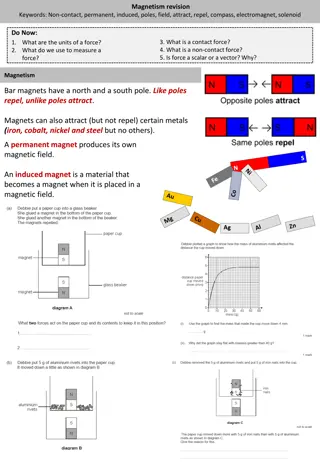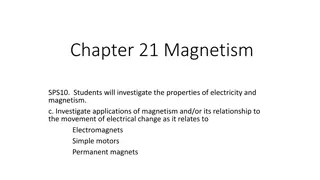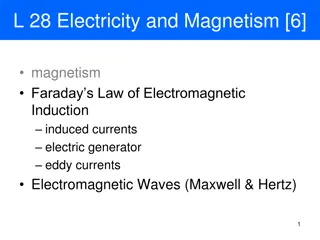Understanding DC Motors in Magnetism: Practical Applications and Concepts
Delve into the world of DC motors as an application of fundamental magnetism principles, including Fleming's Left Hand Rule and induced potential. Explore the structure, function, and optimization of DC motors through detailed explanations and engaging activities.
Download Presentation

Please find below an Image/Link to download the presentation.
The content on the website is provided AS IS for your information and personal use only. It may not be sold, licensed, or shared on other websites without obtaining consent from the author. Download presentation by click this link. If you encounter any issues during the download, it is possible that the publisher has removed the file from their server.
E N D
Presentation Transcript
L1 Introduction to magnetism L10 Loudspeakers & Microphones L2 Compasses L11 Transformers L3 EM practical L4 Solenoid L5 Force on a current carrying wire L6 Fleming LHR L7 Motors L8 Induced potential L9 Generator effect Lesson Sequence Pupils should have been taught to: Pupils will be taught: Students have learnt F-BIL, and Fleming s LHR. The electric motor is really an application of these two lessons. Therefore there is plenty of opportunity for consolidation of prior lessons. Students will cover loudspeakers, generator effect, microphones and transformers. Future Learning Specification Prior Learning
SciDoc 29/09/2024 DC motors DC motors Last Lesson Last Term Last Year Stretch & Challenge I do We do You do Test I do We do You do Do Now
SciDoc Keywords Learning Objectives Keywords Current Commutator Flux density Motor Carbon brush Describe the structure of a DC motor. Explain the role of a split ring commutator. Describe how to make a DC motor stronger/spin the other way. I do We do You do Test I do We do You do Do Now
SciDoc DC Motor DC Motor A DC motor is made out of a coil of wire within a magnetic field. Stretch: What happens to the direction of the force when the coil rotates 180 degrees? There is an equal and opposite force on each side of the coil. I do We do You do Test I do We do You do LO:
SciDoc Commutator Commutator A split ring commutator changes the direction of current every half turn. This is due to two halves swapping from one carbon brush to another. Stretch: The commutator disconnects the current every half turn. Why doesn t the motor stop? I do We do You do Test I do We do You do LO:
SciDoc DC Motor DC Motor How could we: 1)Make the motor spin in the opposite direction? 2)Make the motor spin faster? I do We do You do Test I do We do You do LO:
SciDoc Worksheet Worksheet Complete the worksheet I do We do You do Test I do We do You do LO:
SciDoc Basic answers Basic answers Q1. A N M Q2. Because the direction of the current is going in the opposite direction. Q3. Anti-clockwise. I do We do You do Test I do We do You do LO:
SciDoc Medium answers Medium answers Q4. Reverses the direction of current every half turn. Q5. Because the momentum of the coil keeps the motor spinning. Q6. Increasing the current in the coil, increasing the magnetic flux density of the magnets. Q7. Reversing direction of the current, reversing direction of the magnetic field. Q8. The current creates a magnetic field [1] This magnetic field interacts with the magnetic field of the magnets [1] Which creates a force, and causes the coil to rotate [1] When the coil has rotated half a turn, the split ring commutator reverses the current direction [1] So that the coil continues rotating in the same direction [1] Q9. Potential difference has decreased, so current decreases. This reduces the force of the motor. I do We do You do Test I do We do You do LO:
SciDoc Hard answers Hard answers Q10. The split ring commutator reverses the direction of the current every half turn [1] This keeps the turning force in the same direction [1] Q11. It will rotate a half turn, and then experience a force in the opposite direction. It will come to rest in a vertical position. Q12. The resistor decreases the current in the circuit [1] This reduces the force on the coil [1] Q13. The size of the current, iron core, number of turns in the coil. I do We do You do Test I do We do You do LO:
SciDoc Struggle time! Struggle time! Exam question so exam conditions! You have 8 minutes! I do We do You do Test I do We do You do LO:
SciDoc Greater the speed, the greater the force Smaller the radius, the greater the force Doubling the speed quadruples the force 12,000N I do We do You do Test I do We do You do LO:
SciDoc Current creates a magnetic field This interacts with the permanent magnetic field and produces a force. Because side B is parallel to the magnetic field lines I do We do You do Test I do We do You do LO:
SciDoc Increase current/strength of magnetic field I do We do You do Test I do We do You do LO:
